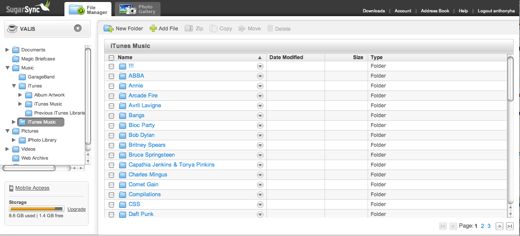 A start-up called Sharpcast has just taken a huge step toward the dream of creating and accessing data on any device, anywhere. After four years of development, the company has unveiled its service SugarSync, which uses the online “cloud” to sync files across multiple computers and mobile devices.
A start-up called Sharpcast has just taken a huge step toward the dream of creating and accessing data on any device, anywhere. After four years of development, the company has unveiled its service SugarSync, which uses the online “cloud” to sync files across multiple computers and mobile devices.
We’ve been excited about the company for a while, because it looked to be creating the “killer app” in this field. That excitement, in part, is why we sounded a little underwhelmed in our coverage a year ago, when Sharpcast launched with only a photo service. But SugarSync looks to be the real deal. For example, when you upload a Word document onto one computer, SugarSync will automatically download that document to all your devices, and it will update the file as you edit.
SugarSync’s closest competitor may be DropBox, which came out of secret testing mode about a week ago (our coverage). But SugarSync has a number of significant advantages, including compatibility with mobile devices and televisions — namely, you can view and download files to your smartphone, and you can even view some of your photos and other media on a web-connected TV. Also a huge plus is the fact that SugarSync can sync any file on your computer, not just those in a specific folder or “dropbox”. The less a sync service requires you to change your behavior, the better.
Big tech players want to enter this field. Microsoft announced earlier this month that it’s trying to develop similar “mesh” technology. But Microsoft is still in development mode, while SugarSync is a reality, notes chief executive Gibu Thomas. And since one of sync’s big goals is to link files across platforms and operating systems, it helps that — unlike Microsoft — SugarSync doesn’t have anything at stake in the OS fight.
“When you’re building bridges, you want to be Switzerland,” Thomas says. “I don’t have any fiefdoms to protect.”
So here’s how it works: After you install SugarSync, you select the folders that you want to be automatically synchronized. (If you don’t want your entire Documents, Movies and Photos folders to be synced, you can just use the “Magic Briefcase”, a folder that seems to function similarly to DropBox.) After that, SugarSync runs in the background; if one of your SugarSync-enabled devices is turned off or goes offline, it will automatically update once you go online again. There’s also a “Light Sync” option, which allows you to keep abreast of updated files, but won’t actually download them to your computer or device until you want it to. You can also share and sync folders with your friends and coworkers.
I’ve only got one computer (hey, I’m on a journalist’s salary), so SugarSync is a little less useful for me. Still, by uploading all of my content onto the cloud — in other words, SugarSync’s server — I can now access all of those folders from any location, as long as I can get onto the Internet. And to put it simply, the fact that this afternoon I uploaded eight gigabytes of documents, photos and music onto the “cloud” is really cool. (See screenshot below. Yes, I’m an ABBA fan.)

Following this free trial period, SugarSync will charge for monthly subscriptions. Thomas says he also hopes to strike licensing deals with carriers, so that AT&T or Verizon, for example, could offer a service to sync music between your computer and a mobile device. Long-term, Thomas wants to release SugarSync’s APIs so that developers can build other applications around the company’s sync technology.
Palo Alto, Calif.-based Sharpcast has already raised two rounds of venture funding worth $16.5 million, and Thomas says he’s in the middle of raising a third.

